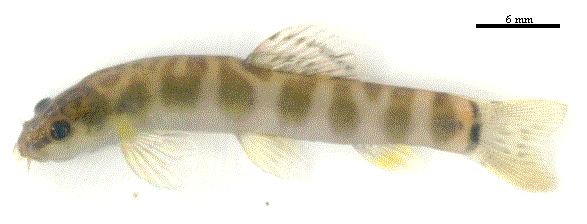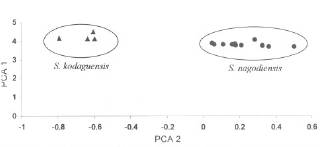2. Schistura nagodiensis sp. nov. |
| 2.1 Material examined |
Holotype: 26.xii.2003, Sharavathi river (13°54'40"N-74°53'49"E), Algod, Shimoga, Karnataka, coll. Sreekantha and Vishnu D, F-7595 ZSI/SRS, 28.0mm SL.
Paratypes: 12 exs., Sharavathi river (13°54'40"N-74°53'49"E), Algod, Shimoga, Karnataka, coll. Sreekantha and Vishnu D, 28.0mm SL and25.0mm SL, F-7596 ZSI/SRS, 26.xii.2003; 25.0mm SL, 25.0mm SL, 26.0mm SL, 25.0mm SL, 26.0mm SL, 26.0mm SL, 25.0mm SL, 26.0mm SL, 25.0mm SL and 23.0mm SL IISc/CES/ WGBlS: 3-5-3-5-007.
2.2 EtymologyNamed after its type locality, Nagodi tributary of Sharavathi river, central Western Ghats.
2.3 DiagnosisA species of Schistura depicted in Image l, distinguishable from other members by the following combination of characters; processus dentiformis present; 6-9 broad dark brown bars on body, the anterior bars not reaching ventral side; males without a suborbital flap; posterior extremity of anterior nostril prolonged in a filament; incomplete lateral line extending to half length of pectoral with 8-10 pores; lower lip with a black mark on each side of median interruption (Image 2); 8 1/2 dorsal rays, 7-9 pectoral, 6 pelvic and 9+9 caudal rays; deeply emarginate or slightly forked caudal fin; black basal caudal bar, sometimes interrupted; caudal fin with two rows of spots; no axillary pelvic lobe; anus much nearer to anal fin; weakly developed adipose crest on peduncle.

Image 1: Schistura nagodiensis sp. nov.(SL 26.0mm) paratype from type locality,(IISc/CES/WGBIS : 3-5-3-5-007)
Image 2: Schistura nagodiensis - Ventral view of head
| Back |
Morphological data and their proportionate values are listed in Tables 1 and 2 respectively. A relatively small species (largest 28mm in SL) compared to other species of Schistura with moderately elongated body, rounded anteriorly to origin of dorsal fin, slightly compressed thereafter; head depressed; snout obtuse; mouth semi-circular; lips thin, upper lip with a small incision in the middle, lower lip with a black mark on either side of median interruption; anterior nostril pierced in the front, posterior extremity prolonged in a filament; eyes large, diameter equals inter orbital width; barbels-inner maxillary shorter than outer, outer maxillary shorter than nasal, not extending to margin of eye; processus dentiforrnis present; incomplete lateral line with 8-10 pores, extending to half length of pectoral fin; cephalic lateral line system with 6 supraorbital, 4+10 infraorbital, 9 preoperculomandibular and 3 supratemporal pores; fin ray counts, dorsal 2/81/2 , pectoral 7-9, pelvic 1/6, anal 2/5 and caudal 9+9; dorsal fin equidistant from tip of snout to caudal fin base; distal margin of dorsal fin slightly convex; pelvic fin inserted slightly behind the origin of dorsal fin; anal fin at three quarters of SL, not reaching base of caudal fin; pectoral fin reaches half the distance to pelvic origin, pelvic fin extends beyond anus; caudal fin without axillary lobes, varies from deeply emarginate to slightly forked; weakly developed adipose crest on caudal peduncle.
| Back |
Live specimens (in natural condition) light yellowish-brown with 6-9 dark brown cross bars, broader than interspaces; preserved specimens creamy white with black cross bars; bars broader along the lateral line, without reaching ventral surface and restricted to upper two-third of body except near caudal peduncle; near caudal peduncle extend to ventral surface; head and snout mottled with dark black spots; a shade of wine red on entire body surface, intense on dorsal fin in live specimens; two rows of spots at one quarter and three quarters of the height of dorsal fin; band on caudal fin base varies from dot to dissociate to complete; a prominent dark black spot on each side of median interruption.
2.6 HabitatSpecimen was collected from the Nagodi tributary, a perennial tributary of river Sharavathi with annual rainfall of over 5500mm. The catchment of this tributary is endowed with numerous torrential hill streams and vegetation cover (nearly 88%) (Figure 4a). Vegetation cover comprises of evergreen to semi-evergreen (36.54%), moist deciduous forests (20.04%), plantations (26.28%) and agricultural area (1.03%). The species is aptly named after the tributary to signify its occurrence as well as habitat preference.
Figure 4: Classified Image of the corresponding watersheds of the collection localities (a) Catchment of Algod (b) Catchment of Dabbefalls
| Back |
2.7 Distribution
Sharavathi river basin, Central Western Ghats, Karnataka, India
Characters such as elongated body with almost uniform depth, blunt snout, inferior mouth, dorsal fin inserted opposite to pelvic fin, with eight branched rays, emarginate caudal fin, pelvic fins not extending up to anal fin, body with scales, a dark band on the base of caudal fin, presence of characteristic colour pattern on the body in terms of cross bands and a band at the base of caudal fin indicates that this species is a member of Schistura genus.
Diagnostic features highlight that the new taxon has unique combination of characters compared to any other species of Schistura reported so far in Menon (1987), Kottelat (1990), Talwar and Jhingran (1991), Kottelat (2004), Vishwanath and Shanta (2004), Vishwanath and Nebeshwar (2004), and Vishwanath and Sharma (2005). Comparison with the species of Western Ghats is provided in Table 3. Schistura nagodiensis is comparable only to S. kodaguensis Menon . However, it differs from S. kodaguensis, which has 11-14 bands, tapering below, caudal fin slightly emarginate, dorsal with a light margin bounded below by an arched black band and a dark base. It resembles to S. robertsi in the presence of black mark on the median part of lower lip, prolonged nasal filament, and banding pattern on the body, while differing in caudal fin (emarginate and with one row of dark pigments on the proximal area in S. robertsi), dorsal branched rays (71/2), caudal rays (8-9+8 in S. robertsi ). Plot of principal components (of PCA) gives distinct clusters indicating variations between S. nagodiensis and S. kodaguensis (Fig. 2). Eigen value of PC 1 is 264.2 (accounts for 98.85% variability) and PC 2 is 2.63. Appendix-I provides identification keys to new species.

Figure 2. Plot of principal components of 31 morphological parameters - Schistura nagodiensis and S. kodaguensis
| Back |
Schistura kodaguensis : 06.x.2004, Kootu Hole (l2°26'59"N75°42'46"E), about 8km northwest of Mercara, Coorg, Karnataka, 2 exs. 23.0mm SL and 29.0mm SL, coll. Sreekantha, Vishnu D. and Gururaja K. V., IISc/CES/WGBIS: 3-5-3-5-005.
Schistura nilgiriensis : 06.xi.2003, Sharavathi river, Niluvase (13°44'18"N-7 5°06'30"E), Shimoga, Kamataka, 2 exs. 39.0mm SL. and 43.0mm SL, coll. Sameer Ali, Gururaja KV and Vishnu D, IISc/CES/WGBIS: 3-5-3-5-004.
Schistura denisoni denisoni : 21.xi.2003, Sharavathi river (13°52'44"N-75°03'64"E), Jayanagar, Shimoga, Karnataka, 2 exs. 31.0mm SL and 39.0mm SL, coll. Sreekanthaand Vishnu D, IISc/ CES/WGBIS: 3-5-3-5-001.
Schistura semiarmatus: 23.xi.2003, Sharavathi river (75°03'52"N]3°52'45"E) Suttha, Shimoga, Karnataka, 2 exs. 32.0mm SL and 34.0mm SL. Coll. Sreekantha and Vishnu D, IISc/CES/WGBIS: 3-5-3-5-006.